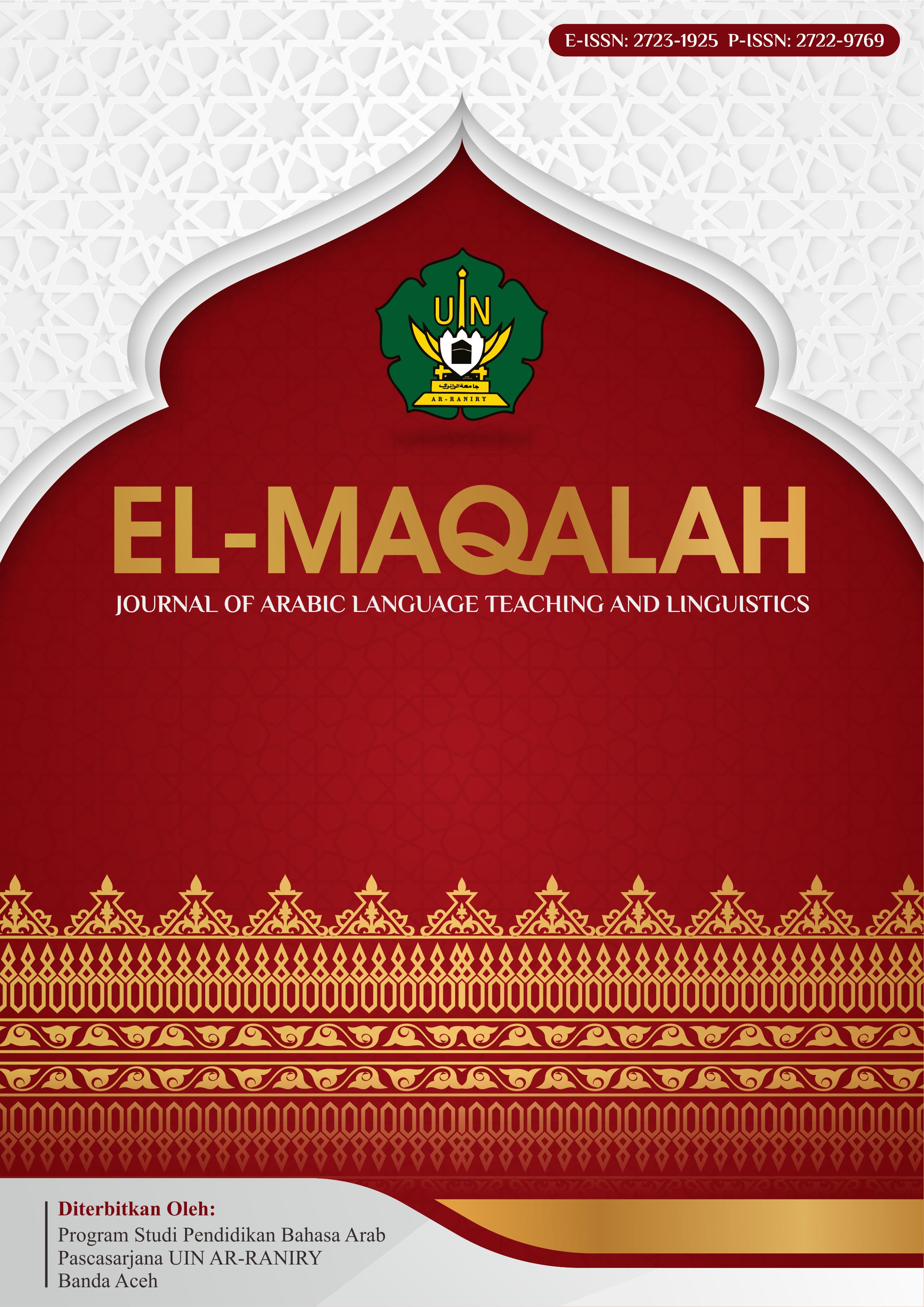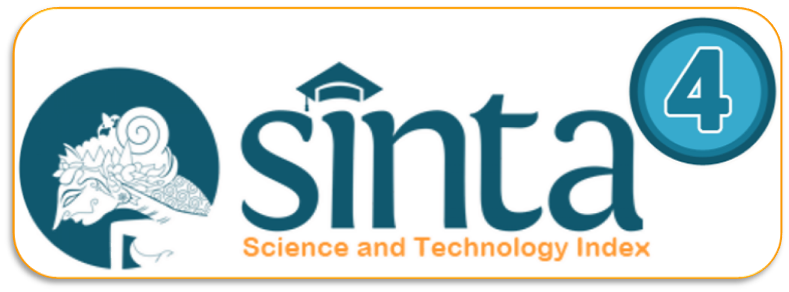Aṡar Istikhdām al-Qiṣṣah al-Muṣawwarah Bi aṭ-Ṭarīqah al-Mubāsyirah Fī Tanmiyah at-Ta`bīr asy-Syafawī Laday Ṭalabah aṣ-Ṣaff al-Awwal aṡ-Ṡānawi (Dirāsah Tajrībiyyah Bi Madrasah Insān Quranī, Aneuk Batee)
(أثر استخدام القصّة الـمصوّرة بالطريقة الـمباشرة في تنمية التعبير الشفوي لدى طلبة الصف الأول الثانوي (دراسة تـجريبية بـمدرسة إنسان قرآنـــي، أنوك باتو
DOI:
https://doi.org/10.22373/maqalah.v2i1.1236Keywords:
Stories, grammar, Verbal ExpressionAbstract
The Students of Modern Islamic Boarding Schools are distinguished in learning a variety of languages, one of which is Arabic. The teacher's method in Arabic learning is by using the audiolingual method. This method mostly involves memorizing vocabulary and Arabic grammar. However, the educators mostly use dialogue methods in teaching, of course; this process will be a good attempt to improve the ability of students to chat in Arabic. But in fact, many students are weak and unable to match the vocabulary and Arabic grammar that have memorized in the conversation. Therefore, the researcher examined the topic "Implications of Using Direct Picture Stories in the Development of Expressing Verbal Expression" to facilitate students in applying what they have learned from Arabic vocabulary and grammar in order to improve their ability to express these expressions. The purpose of this research is to identify the effectiveness of the direct method with the illustrated stories media in improving the ability of oral expression and its application in Arabic subjects for first graders Madrasah Aliyah Insan Qur'ani. The research method is experimental, therefore the researcher collects data based on test result data from the application of the method using empirically illustrated stories. The object group in this study is all the first graders of Madrasah Aliyah Insan Qur'ani Aneuk Batee which numbered 174 students. The researcher selected several samples and made them two classes of students, namely class D as a control group of 20 students and class E as an experimental group with 20 students. The result of this study is that the application of a direct method with illustrated stories in the learning of expressing expressions orally is effective in improving students' ability in conversation. Because the T-Test score in the calculation is 2.93 greater than the T-Test table value of 1,685. So the difference between the experimental group and the control group is clear and unquestionable.
References
`Abd Allāh, `Āṭif Muḥammad. Fa`āliyah Wiḥdah Muqtaraḥah Li Tanmiyah Mahārāt Qirā’ah aṣ-Ṣuwar Wa ar-Rusūm al-Murtabiṭah Bi ad-Dirāsāt al-Ijtimā`iyah Laday Ṭullāb al-Marḥalah al-I`dādiyah, Waraqah Muqaddimah Ilā al-Mu’tamar al-`Ilmī ar-Rābi` `Asyar Manāhij at-Ta`līm Fī Ḍau’ Mafhūm al-Ādā’. al-Qāhirah: al-Jam`iyyah al-`Arabiyah Li a-Manāhij Wa Ṭuruq at-Tadrīs, 2002 M.
`Abīdāt, Żuqān Wa Ākharūn. al-Baḥṣ al-`Ilmī Mafhūmuhu Wa Adawātuhu Wa Asālībuhu. Ar-Riyāḍ: Dār Usāmah, 1997.
Ainin, Moh. Metodologi Penelitian Bahasa Arab. Pasuruan: Hilal Pustaka, 2007.
---------. at. All, Evaluasi Dalam Pembelajaran Bahasa Arab, Cet. Pertama, Malang: Misykat, 2006.
al-`Assāf, Ṣālih Bin Ḥamad. Al-Madkhal Ilā al-Baḥṡ Fii al-`Ulūm as-Sulūkiyah. Ar-Riyāḍ: Maktabah al-`Abīkān, 2000
Badr, Aḥmad. Uṣūl al-Baḥṡ al-`Ilmī Wa Manāhijuhu. Kuwait: al-Maṭbū`ah `Abd Allāh Ḥaramī, 1983.
Kasiram, Moh. Teknik-teknik Analisis Item Test Hasil Belajar dan Cara-cara Menghitung Validity dan Reability, Surabaya: Usaha Nasional, 1983.
Khaṭir, Muḥmūd Wa Yūsuf al-Ḥamadī Wa Muḥammad al-Maujūd Wa Rusydī Ṭa`īmah. Ṭuruq Tadrīs al-Lughah al-`Arabiyah Wa at-Tarbiyah ad-Dīniyah Fī Ḍau’ al-Ittijāhāt at-Tarbawiyah al-Ḥadīṡah. al-Qāhirah: Dār al-Fikr al-`Arabī, 1986 M.
Matsna, Moh. dkk, Pengembangan Evaluasi dan Tes Bahasa Arab, Tanggerang Selatan: Al Kitabah, 2012.
Mughlī, Samīḥ Abū. at-Tadrīs Bi al-Lughah al-`Arabiyah al-Fuṣḥā Li Jamī` al-Mawād Fī al-Madāris. `Imān: Dār al-Fikr, 1997.
Mulḥam, Sāmi Muḥammad. al-Qiyās Wa at-Taqwīm Fī at-Tarbiyah Wa `Ilm an-Nafs. `Imān: Dār al-Muyassarah, 2000 M.
Sujana, Nana Dasar-Dasar Proses Belajar Mengajar, Cetakan Pertama, Bandung: Sinar Algesindo, 1989.
Ṭa`īmah, Rusydī Aḥmad. Al-Marāji` Fī Ta`līm al-Lughah al-`Arabiyah Li an-Naṭiqīn Bi Lughāt Ukhrā. Al-Juz a-Awwal. Makkah: Jāmi`ah Umm al-Qurā Ma`had al-Lughah al-`Arabiyah, Dūn as-Sanah.





























